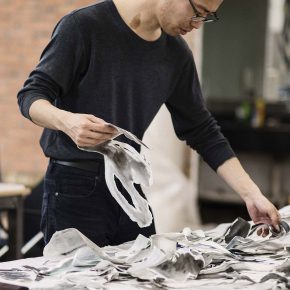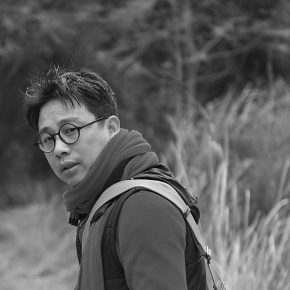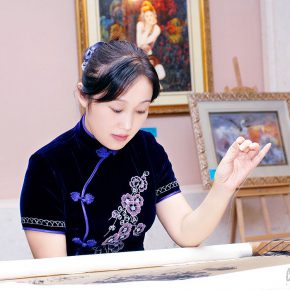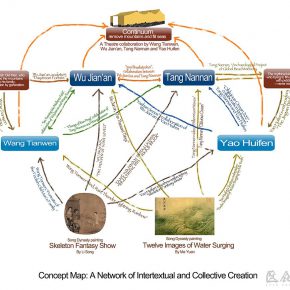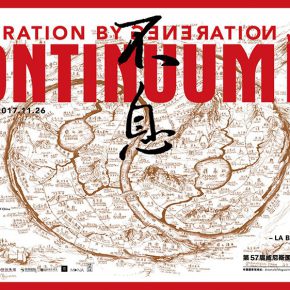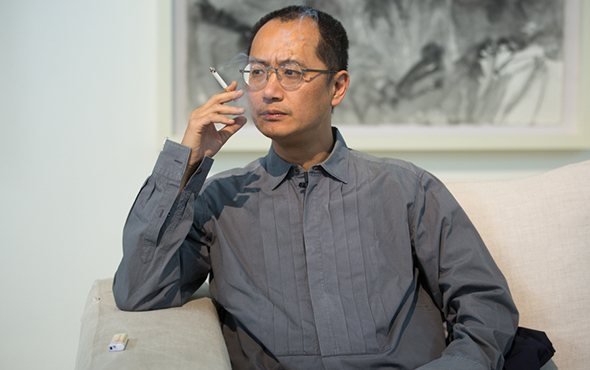
The 57th Venice Biennale will be held from May 13 to November 26, 2017. The China Pavilion invites Qiu Zhijie, Dean of the School of Experimental Art, CAFA to serve as the curator, together with the artists Tang Nannan, Wu Jian’an, Wang Tianwen and Yao Huifen who will participate in the exhibition themed on “Continuum: Generation by Generation”. The exhibition curator Qiu Zhijie was interviewed by CAFA ART INFO a month before the exhibition, to explore the theme of the exhibition, the experience of the birth of a concept, and for an analysis of the Chinese art development model behind the exhibition.
Interview Time: April 9, 2017
Interviewer: Zhang Wenzhi
Venue: Qiu Zhijie Studio (Beijing)
CAFA ART INFO: Hello, Prof. Qiu. The Venice Biennale of the year is themed on “Viva Arte Viva”, while the China Pavilion is themed on the “Continuum: Generation by Generation”, which is a concept with a Chinese implication, and also a good interpretation of the chief theme. Seen from the curatorial idea, does it resonate and create dialogue with the chief theme?Qiu Zhijie: In fact, the Venice Biennale does not ask nor expect each national pavilion to respond to each chief theme, but we have this practice, and unconsciously respond to it. This year I planned the exhibition for the China Pavilion which clearly echoes the theme of the Venice Biennale the “Viva Arte Viva”, artists die generation by generation but art is immortal, when this concept is implemented into the program of the China Pavilion, is it how the Chinese people think and deal with this problem? It is the question of the exhibition that we are going to answer.
I often say that art is created by generations of artists, art is “Continuum”, and this understanding actually comes from my own childhood experience. I still remember when my calligraphy teacher died in my childhood, I used his style of calligraphy to write all the wreaths and elegiac couplets, which made the local circles of calligraphy cry, why was I able to write my teacher’s calligraphy, I think it is a continuum, when I wrote a stroke, many things from my ancestors flowed through my hands. Chinese Calligraphy is a Chinese art form that has never stopped, and many old gentlemen have never ceased the creation of traditional calligraphy even during the environment of the Cultural Revolution, between them there were literati gatherings with the contents replaced by Chairman Mao’s poetry, making traditional art in their own creative way. After the end of the Cultural Revolution, the elderly literati came from all corners of China and taught the traditions to me. I would like to think that, Chinese culture has a tough vitality, like bamboo, falling down when there is a wind, standing up when the wind is gone, as long as it is in a good situation, it will resurge, so that it is a power of continuum.
Therefore, I would like to answer this “Viva Arte Viva”, the individual artist will disappear, but this force is continuum, and this power is called the power of the foolish old man who removed the mountains. Chinese people do not believe in immortality, and in fact, Chinese people do not believe in monuments, China has produced the world’s strangest monument – Empress Wu Zetian’s Wordless Memorial Tablet. The Inscriptions on precipices on Mount Tai are usually called the monuments in China, and they were superimposed by different individuals from generation to generation. Therefore, the Chinese people believe in “continuum”, namely the immortality, which refers to the Taihang Mountains, Wangwu Mountains were destroyed by the foolish old man’s family, and in fact, it reveals the power of the intergenerational transaction.
CAFA ART INFO:You have just started from your own experience to talk about the theme of the concept of “continuum”, which is the power passed down by the intergeneration. Does this exhibition try to start from the perspective of the timeline, from the perspective of “orderly circulating” to elaborate the growth pattern of Chinese art?Qiu Zhijie: It is not only the timeline, but also the things between individual artists. Chinese artists’ self-energy that was relatively weak, never focusing on the myth of the individual creation, and we have a concept called “density of literature", which meant that there is a density of literature and art, when Su Dongpo returned after sailing across the sea from Hainan Island, he said “Literati is not destined to die”, which meant that the art has its own destiny and the own energy, so that each individual artist from China considered himself to be like a tool to create the prosperity of literature. Our artists would play the game of literati gathering, where the artists often cooperated, one would draw a stone, one would draw a flower, one would replenish grass leaves, and one would write a poem, and then the person who was good at calligraphy wrote this poem on the paper, many works were finished in this way. The artists were also engaged in the game of mutual exchange reaction and making a response, one would write a poem, and another used his rhyme to write a new poem, the game would never stop until the last person failed to answer it. In this game one would consider someone else’s creation as a chance, and it is a way to run the endless flow of energy. This approach also involves how the individual artists organize and the identity of the artist, for example, when Wang Xizhi organized the Gathering of Literati at Lanting, he was a curator, when he called Wang Youjun, he was an official, and his artist’s identity was not tied to a position through the professional system.
CAFA ART INFO: The Venice Biennale is a show about contemporary art. You have just talked about the models of “intergenerational transmission” and “literati gathering”, whether it exists in contemporary art creation and prompts a creating method and idea for Chinese contemporary art? Because some of the four artists participating in the exhibition have engaged in contemporary art creation, and part are engaged in the traditional process.Qiu Zhijie: First of all, it is not necessary to define the Venice Biennale as a contemporary art exhibition, as the Venice Biennale is about art. Today, all types of art are contemporary art in the context of the Venice Biennale, there is not any traditional art or conservative art, and it is not a definition for contemporary art, so nobody could tell you what isn’t contemporary art and what is contemporary art. For myself, I am critical of contemporary art, because all art is critical of the art concept which has been formed at that time. For the Venice Biennale is an art biennale, it should bring together the criticism of the current working of popular art, and then I think the interactive working style of literati gathering that we are talking about today is both a criticism for the present popular culture of exhibitions and a contribution to the Venice Biennale.
CAFA ART INFO: The exhibition of the national pavilion is a practice for the Venice Biennale, a country is responsible for a venue and an exhibition, for the audience, they unconsciously make a comparison between the countries and exhibitions, is there a “national consciousness” when you are engaged in the planning of the exhibition? Was it necessary to present the show representing the artistic state of the nation to the world.Qiu Zhijie: Although it did so in the era when the Venice Biennial was first established, few people ask for it now. The Venice Biennale was born in 1895, when it was the era of the Expo, and it was also the era of the re-emergence of the modern Olympic Games, so it established the national pavilions. At the end of the 19th century, because of the expansion of the colonialism and imperialism, it gave birth to nationalism, and the concept of the nation-state beginning to flourish around the world, so the Venice Biennale was born in an era of great nationalism. At that time, major countries, such as Britain, France, Germany and the United States, established their national pavilions which aimed at showcasing their own prosperity, but this idea was also very dangerous, for example, in the Expo at that time it was dedicated to establishing a part of the race show, where the captured African Negroes locked like animals in the zoo on show, and it appeared like a concept about “human zoo”. Today, the traces of consciousness still exist, such as the Window of the World, folk customs, parks, etc. In the early Venice Biennale this meaning was explicit but in the last ten years, along with the process of globalization, people began to reflect on the impact of nationalism and each state on the Biennale, so that you can see the Germany Pavilion and the Pavilion of France have exchanged their venues, and many countries invite artists from other countries to attend their national pavilions. The way to show a positive image of the country is now refused by the Venice Biennale.
I would like to make a comparison. The Olympic Games is the place where the national strength is showcased, the slogan of the Olympic Games is “Higher, Faster and Stronger”, but the countries with relatively poor strength do not have a chance to win a medal, so they could do nothing but say it is not the winning but the participating that is important. It is different in the Expo, which emphasizes the participation, and the Expo is the place where each country’s own characteristics are showcased, Germany is famous for its high technology so it can show its high-tech, Nepal does not have high-tech, but it can also show it sown unique culture. In other words, the Olympic Games is more like a war, while the Expo is more like tourism, where poor countries promote their happiness, which deceives the petty bourgeoisie from Shanghai often traveling to other countries, and it is the function of the Expo. What is the function of the Biennale? It neither shows the prosperity of the countries, nor the characteristics of the countries, national pavilions of the Venice Biennale present the life of the artists who live in their own context, from various countries, as well as their ability tosolveproblems, to some extent it presents problems and difficulties, as well as the solutionused by people in this place. The artists face similar problems and difficulties, how do people from this place solve it, and does this solution inspire the artists from other countries? It is the thing that the national pavilions of Venice Biennale intend to showcase. Of course, it also includes the possibilities of a variety of presentations, for example, it focuses on the growth and model of the young artists from each country each year, while it focuses on an artist’s way of dealing with history in another year.
CAFA ART INFO: Do the creations by the four artists participating in the China Pavilion perfectly explain the way of dealing with artistic problems in China?Qiu Zhijie: Yes, because their focus and their core is cooperation. The so-called artists’ cooperation with folk artisans is actually more difficult to achieve in Europe or elsewhere, but this pattern exists in the European art mechanism, I once worked together with a glass master from Murano Island in Venice, but the glass master did not sign his work after it was finished, so it is different from the concept that we both have to sign after working together on one pieces of work. We would promote many new cooperative models in this exhibition, the art of Tang Nannan and Wu Jian’an will allow Wang Tianwen and Yao Huifen’s process some new questions, such as the cooperation between multimedia art and shadow puppets which might be the first experience for Wang Tianwen, while Yao Huifen might also embroider things that never appear in Suzhou embroidery. The whole exhibition fuses with each other and the specific creative face is still a secret.
CAFA ART INFO: In the 1980s, China appeared in the Venice Biennale with the traditional folk art forms, so we look forward to a completely different understanding of the shadow puppet and Suzhou embroidery in that year.
Qiu Zhijie: In the 1980s, the cultural managers didn’t know the Venice Biennale, but might consider it as a trade fair, which was similar to the Canton Trade Fair. But recalling the historical situation at that time, the elite artists were thinking of how to reshape folk art of China, thinking of the role of arts and crafts, and China did not have anything to export at that time, while the only thing that can be used for foreign exchange is the arts and crafts, the new China spent a lot of energy to cultivate stone carving, embroidery and New Year paintings and the arts and crafts were preserved in the turmoil of the Cultural Revolution with this concept. When I investigated Quyang stone carving, I found that many artisans secretly studied and inherited this skill during the Cultural Revolution, as soon as 1971 they began to organize production and exported it from Tianjin. Therefore, it is also very logical to send the “paper-cut” as arts and crafts to participate in the Venice Biennale in 1981. Thirty years later, we have experienced an intense globalization, and a lot of crafts are basically dominated by the market, at this time, some contemporary artists have a desire to re-use these things, rather than video, installation, etc., and I can also combine the traditional crafts to finish my job. And even traditional craftsmen find contemporary artists for cooperation, for example, when Yao Huifen who is engaged in Suzhou embroidery saw the cooperation between Wu Jian’an and Wang Tianwen in Prince Gong’s Palace, she found Wu Jian’an and hoped to cooperate together. The emergence of this interaction is definitely the result of Chinese social development over the past 30 years, so that it is surely not the sense of crafts at that time, the current situation is more complicated. On the one hand, China has the concept of “intangible culture heritage” instead of the concept of arts and crafts at that time; on the other hand, this cooperation has already been a fait accompli, for example, I started working together with the bamboo craftsmen long ago; at last, in comparison with appearing without any knowledge on the international contemporary art at that time, it has a different situation. So this contrast and change is very different.
Translated by Chen Peihua and edited by Sue/CAFA ART INFO


